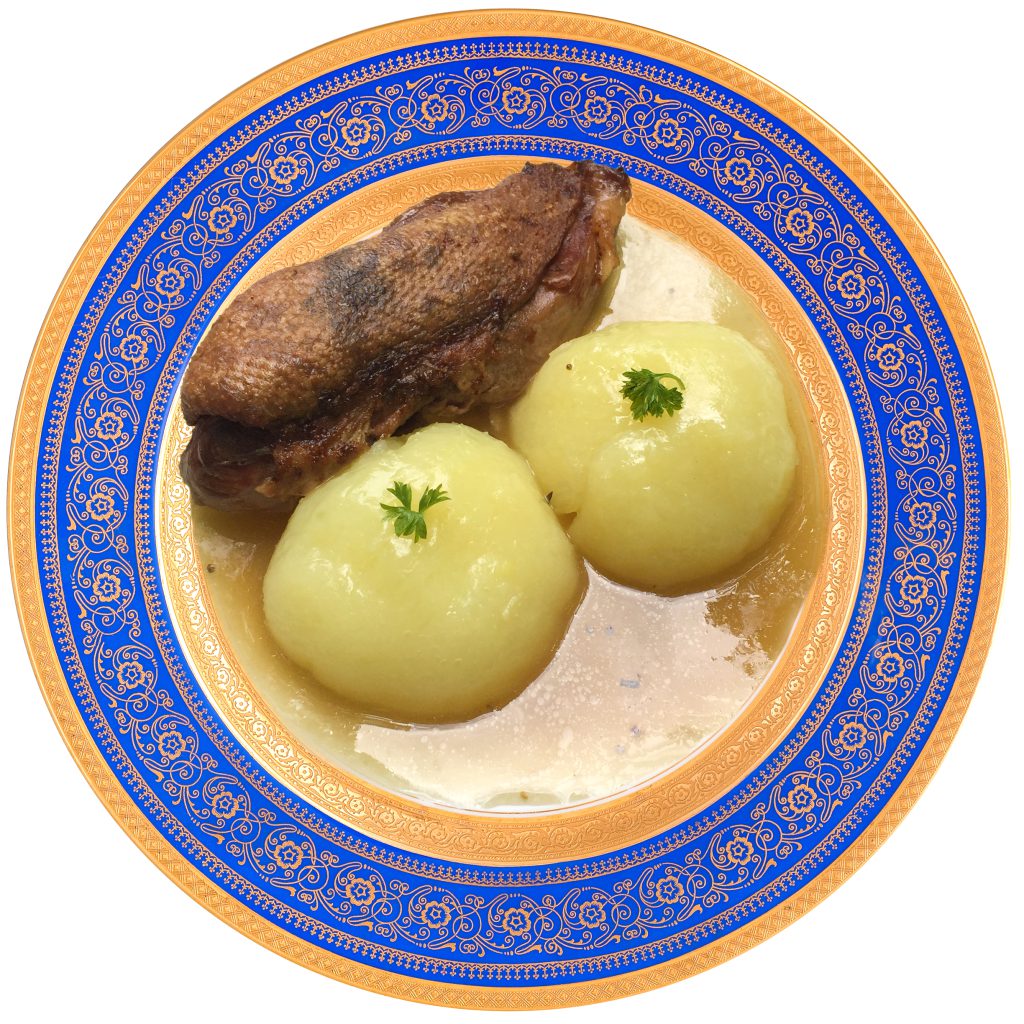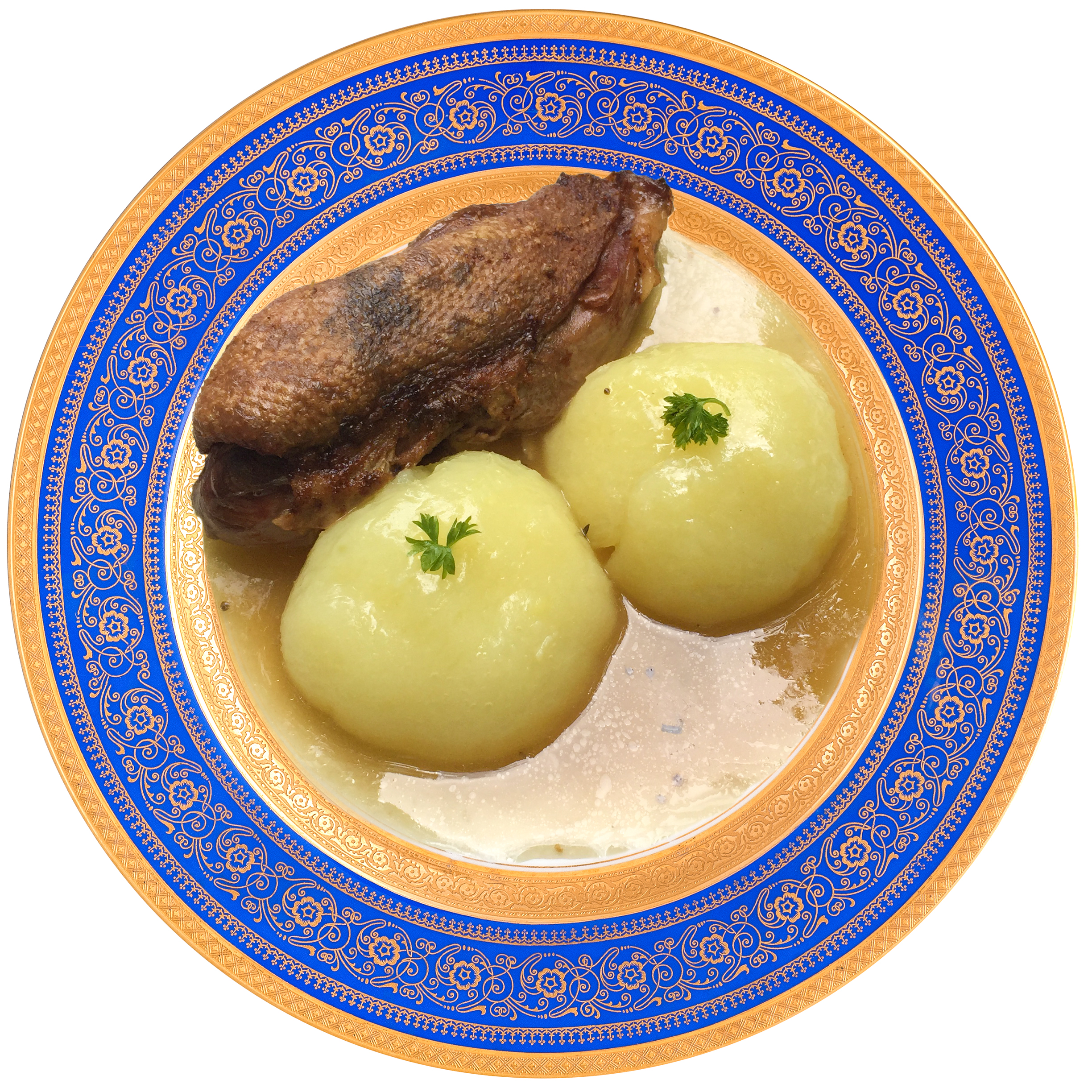December 1944. In what I have described so far, I have tried to familiarize the reader with the Thuringian landscape and the habits of its inhabitants. But this includes, above all, a Sonneberg specialty, the preparation of which has been made so much fuss that I actually have to dedicate an entire chapter to these dumplings. They are not just an accompaniment, like other dishes, but are the highlight of every Sonneberg Sunday meal. Whether rich or poor, they were on everyone’s table, and the housewife always took care of their preparation herself.

During the last years of the war, I regularly gathered with my family and the four Nennstiel boys at Aunt Fanny’s kitchen table on Sundays. When the last worker had left the factory on Saturday afternoon and the bell on the shop door had stopped ringing, Aunt Fanny’s main work of the day began. First she swept the entire factory and then, on her knees, scrubbed the old wooden floorboards of the walkway. When this work was finally completed to her satisfaction, she grabbed a broom and swept the sidewalk along her house.
This habit had become so second nature to my grandmother (Fanny’s sister) that during her stay in the Canada1 she managed to sweep the “sidewalk” in the middle of Toronto one day, much to her daughter’s horror.
At around four o’clock on Saturday afternoon, Mrs. Nennstiel (Aunt Fanny) would regularly wander into the cellar, which led out to an old alley at the back, into which the sewage flowed and where, if you were unlucky, you might encounter a rat. This alley was supposed to have been renovated before the war, but Sonneberg’s money soon went to the armaments industry, and so the “Pandurengasse”, as we children called it and where we played cops and robbers, still exists today in its more than desolate state. Aunt Fanny loaded two buckets of potatoes into the low, very dimly lit cellar and laboriously dragged them up the many stairs to the garden, where she spent the rest of the afternoon sitting in front of the arbor peeling potatoes. Sometimes she ran back to the kitchen and fetched her badly battered brown coffee pot, which normally stood in a corner on the stove all day. If God was particularly kind to her, the Kathreiner brew2 also contained a few beans of real coffee, which Werner sometimes sent her from France.
The actual cooking began early on Sunday morning. While the men used to quickly disappear into the Gambrinus3 for a couple of beers, the housewife would first take care of the roast. However, not much fuss was made about it. It was a given that it always turned out perfectly.
During the last year of the war, the weekly meat ration for four people was about 300g of meat. If the cook really wanted to satisfy us children, she had to conjure up at least two liters of the best gravy from this little piece of meat. We never understood the moaning that there wasn’t enough meat for it, we didn’t want roast meat anyway; only the five to ten dumplings that we devoured one after the other had to swim in plenty of good gravy.
A lot of equipment was needed to prepare the dumplings. First of all, a large enamel bowl with a curved edge, into which two straps were hung, was needed. The straps were used to hold the bowl in place using a board on the bottom, because only when you put your foot on the pedal did you have both hands free to do the hard work that followed. It was the pride of every Sonneberg housewife to be able to bring the whitest and fluffiest dumplings to the table without any help. You also needed a large cast iron press and a potato sack. This press sack was hand-knitted from thin cotton. The most important instrument, the wooden whisk, was usually carved from the previous year’s Christmas tree. About half of the peeled potatoes were then laboriously chopped on a grater. The women had developed such skill in this work that even the last bit of potato was finely grated without a finger ever being damaged. The grated mash went into the press and after the tap was turned off tightly, a dry ball of pressed potatoes remained in the sack. In the meantime, the rest of the peeled mixture was brought to the boil on the stove and then came the decisive moment. The boiling, thick, bubbling mash was vigorously mixed with the pressed mass in small batches using the large whisk. The housewife stood next to the hot oven, her foot on the strap to make sure the bowl didn’t slip. She beat the dough like a madwoman with both hands and alternately poured in the red-hot mash, which was not allowed to cool down at all or it would not have combined with the rest. The starch content of the potatoes was also very important and you had to have a very good eye to get the right amount, otherwise the dumplings would inevitably be ruined. The women always got very red in the face when doing this work, and it was best not to get in their way. It is no wonder, as macabre as it may sound, that Uncle Oscar’s first wife Marie had a stroke while doing this drudgery.
Everything else was just a matter of routine. The breadcrumbs for the filling were already roasted on the stove, and with the greatest dexterity, around 60 dumplings were formed in a flash and “placed” in a large pot ready for cooking.
Aunt Fanny never set the table without a fresh, snow-white tablecloth and cloth napkins which, although a little threadbare from being washed so often, were artfully embroidered in the corner with the initials F G (Fanny Greuling, her maiden name). The tiny roast was divided equally among all the children. In the middle of the table was a large jar of Bitterer Hölperle-Marmelade4, which was served with each meat dish.
For dessert there was sometimes a compote of grey pears, but Aunt Fanny insisted on serving this simple dessert in her best crystal bowls. Sometimes she had just been hoarding in Gfell5, and then the eggs were enough for homemade vanilla ice cream. But I would rather spare the reader the description of this laborious preparation; it is enough to know that the entire cardboard factory was affected in the process.
When we had really filled our bellies, we were chased out of the kitchen. We were not so badly behaved that we wouldn’t even have helped with the drying, but Aunt Fanny always dismissed this offer with the words “Oh, no,” and of course we weren’t particularly sad about it. She would then sit down alone in her corner by the stove and eat one, or at most two, dumplings. Just at this time, her old school friend Alma would regularly walk in through the kitchen door. In front of her, she would balance a freshly cooked dumpling from her own Sunday production on a plate, and then the usual debate would begin about which dumplings had turned out better. They would compare color and weight, and sometimes Aunt Fanny would be scolded because she hadn’t eaten a piece of meat again and was giving her children her ration.
Every married woman who was even remotely fond of her Sonneberg husband tried the art of making dumplings at least once in her life to surprise her husband. Our mother, a perfect Swabian cook by birth, attempted this hopeless undertaking several times during our years in Leipzig. She had secretly brought all the equipment with her from Sonneberg, and yet her dumplings always fell apart as soon as they were dipped in water, or they became hard as stone and were inedible.
Grandmother Schellhorn managed to send us a straw suitcase by express to Leipzig several times a year, which contained nothing more than about ten genuine Sumbarger dumplings. Of course, the things had turned grey during the journey and could only be fried, but our father always ate them with great pleasure, much to his wife’s annoyance.
Only after our mother had moved to Sonneberg and Aunt Fanny watched closely every Sunday, even if she was not allowed to help, did she gradually learn this mysterious art of making dumplings and finally came to the realization that in Leipzig it must have been due to the hard water, the fake potatoes and possibly also the Saxon air polluted by the nearby Laune factory.
Recently6, during an Alpine Club meeting in Coburg, former Sonneberg residents told me that the dumplings still appear on their table every Sunday, but with the help of modern kitchen appliances, the work is now much easier to accomplish.
Married to a man from Hamburg who has never been a fan of dumplings of any kind, I have thankfully not had to undergo this procedure yet, but I must admit that I love eating them too.
- The original text says USA and Detroit. However, my father told me this same story, which took place in Toronto.
↩︎ - Kathreiner brew, also known as Kathreiner Malzkaffee, is a type of malt coffee that was popular in Germany, particularly in the late 19th and early 20th centuries. It is a coffee substitute made primarily from roasted malted barley, rye, and chicory, and it does not contain caffeine. This brew was marketed as a healthier alternative to traditional coffee, especially for people who wanted to avoid caffeine or could not afford real coffee. It became especially popular during times of economic hardship, such as during and after World War II, when coffee was scarce. The brand Kathreiner was one of the most well-known producers of malt coffee in Germany. The company was originally founded in Munich in the 19th century and became synonymous with this type of coffee substitute.
↩︎ - Gambrinus is a legendary figure in European folklore, celebrated as the icon of beer, brewing, and joviality. Although not a historical figure, Gambrinus has become a symbol of beer culture, often depicted as a rotund, bearded king or duke, holding a tankard of beer. He is sometimes mistakenly referred to as a patron saint of beer, but he is neither a saint nor a deity. The character of Gambrinus has been linked to various historical figures, such as John I, Duke of Brabant, and John the Fearless, Duke of Burgundy, both known for their associations with beer and brewing
↩︎ - “Bitterer Hölperle-Marmelade” refers to a bitter marmalade made from the fruit of the “Hölperle” plant, which is a regional term in some parts of Germany for the jujube fruit (Ziziphus jujuba) or related species. This marmalade is known for its distinct bitter flavour, which is different from the sweeter jams and marmalades made from more common fruits like oranges or berries. The bitterness comes from the fruit itself or from the inclusion of peel or pith in the marmalade preparation.
Bitter marmalades are often enjoyed by those who prefer less sugary spreads and are sometimes used in combination with sweeter foods or in baking. The specific flavour and bitterness can vary depending on the exact preparation and the type of fruit used.
↩︎ - Unknown meaning
↩︎ - The late1970s ↩︎
